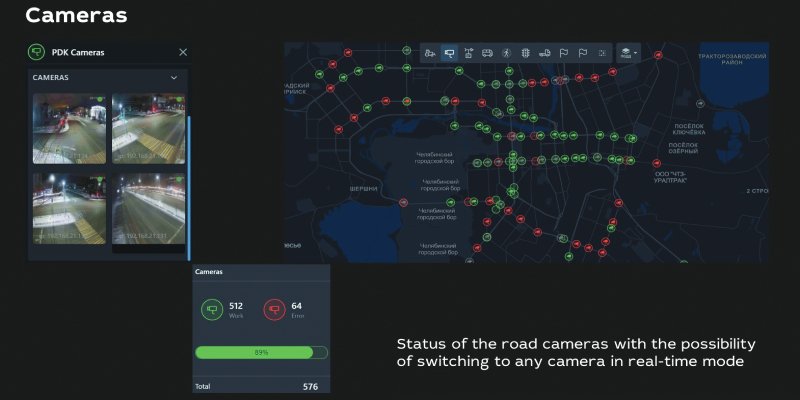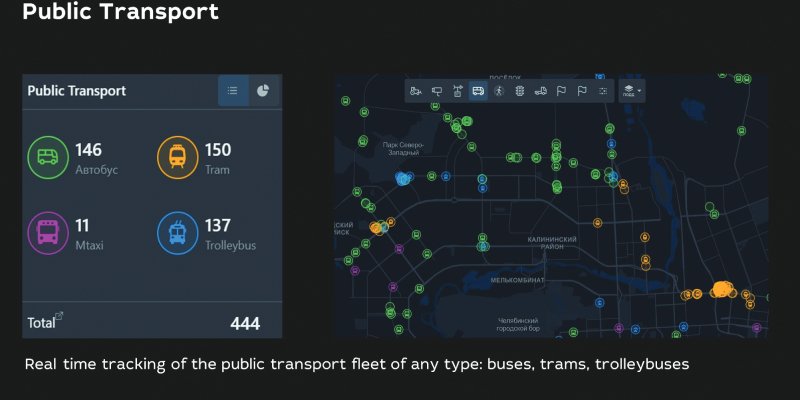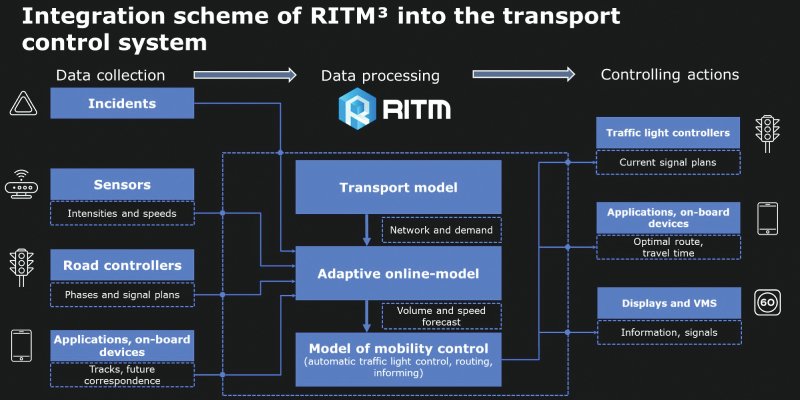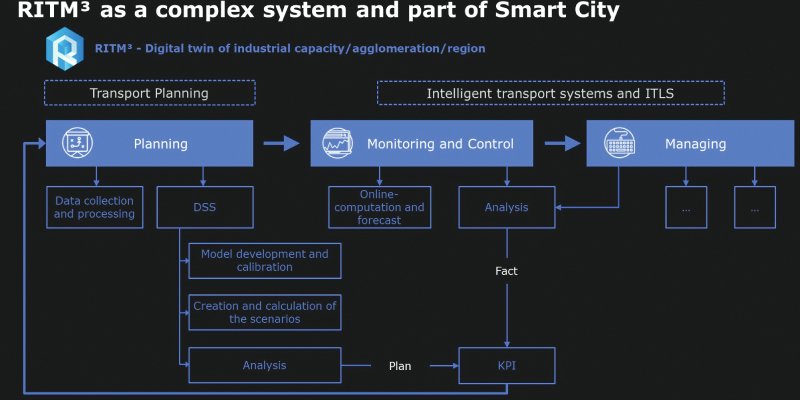RITM3 (Russian word in ITS), developed by SIMETRA, is created as part of the Intelligent Transport System responsible for the upper-level control of the transport complex. Consisting of several modules, each devoted to a special set of tasks, RITM3 allows achieving great flexibility and a comprehensive approach for successful solving of any transport engineering tasks.

From concept to reality
The object of ITS control is the Mobility of transportation of passengers and goods. Forecasting in transport, in turn, is impractical without strong mathematical models. Thus, a true ITS should be based on strong mathematical tools, focus on the comprehensive approach in mobility management, aiming, at the same time, for continuous improvement and development of the integral transport complex.
Considering these, SIMETRA has developed RITM3 – Real-time Integration Transport Measurements Modelling Management was based on several key ideas:
- Mathematical transport model as a core of all modules and tools of digital platform.
- Unified database of transport data of a city/agglomeration/region/country.
- Cross-platform access with a clear, user-friendly interface.
Following these principles allowed the creation of a technological ecosystem for solving any type of transport engineering problem.

Main features
RITM3 can be considered a complex system and a part of a Smart City. It acts like a digital twin of industrial capacity/city or region.
The system is a universal integration platform that allows the collection of any kind of transportation data from different sources like mobile applications, phases of light controllers, intensities, and speeds of traffic flows from the road sensors, as well as information about incidents. It can easily be integrated into any transport control system, and serves as a big stockpile for the data, and provides a vast embedded set for data analysis and processing.
A transport model or a master plan is a ‘skeleton’ of the transport planning and management, which can then be filled with the processed RITM3 data, resulting in the adaptive online model. The last can further be used for real-time management and forecasting. Some real-time management actions performed by the system may include control of traffic lights (signal plans and phases), real-time update of the optimal routes and travel time for the mobile apps, management of road displays, and VMS.
Integration of RITM3 to the transport managing system.
The main advantage of RITM3 is its integrity, data collection, data processing, analysis and forecasting, as well as management, are taking place at a single platform enhancing the quality and speed of decision making. Such a great functionality of RITM3 is achieved by the combination of its modules dedicated to the specific tasks.
Today RITM3 consists of 4 functional modules
– Web GIS and online Master-plan
– Vehicle Monitoring and Management
– Transport Modelling and Forecasts
Modules’ functionality
Each module is related to a specific set of problems and works independently from other modules. That means, that one doesn’t have to buy the whole system but can purchase 1 or 2 modules that are necessary for certain tasks.
Web GIS and online Masterplan
The module is a GIS map with overlaid functional layers. These layers display information and interactive points of interest (POI), showing data about different types of events like road accidents, road closings, etc.
The module enables displaying and editing of road schemes and point objects; displaying of the traffic congestion diagram of the road network, export of maps and schemes in different formats.
Traffic Control Center
This module contains many widgets that form a unique interface providing visualization of all necessary data on a single screen. There are special widgets for real-time monitoring of traffic lights, video cameras, weather, road engineering, etc. There is also an option of adding different types of events occurring on the network. Actual information about the events allows simulating their impact on the traffic situation on these sections for the short-term forecast.
Vehicle Monitoring and Managing
The module displays city service vehicles as well as vehicles involved in imports and domestic deliveries of inventory goods and cargo (for the case of an industrial facility) on the interactive map.

Transport Modeling and Forecasts
This module provides an ability to assess the impact of the events happening on city streets on the development of the transport situation, as well as manage the traffic flow distribution throughout the network. SIMETRA’s algorithms and algorithms of PTV Visum software are used for scenario calculations. The module is also designed for automatic identification of trends (increase/decrease in the number of occurring events), forecasting of frequently repeating events based on statistical data from other functional modules.
The roster of public transport (embedded in the module) provides an ability to form the route network and to maintain schedules based on transport graphs using a specialized router. According to various indicators, the efficiency of routes can be calculated. Another opportunity of the module is aggregated recording and visualization of traffic measurement results at intersections and road sections with the detailing ability on approaches and directions.
RITM3 will suit you well, if you are a…
– Transport Engineer (to automate routine tasks and prepare analytical materials on request)
– Head of a municipality in the field of transport (to improve the quality of management decisions)
– Analyst (to collect and visualize data in a single interface)
– Civil society representative (to receive and send information about the current status of the transport situation)
Although RITM3 is relatively new system, many clients in Russia and CIS countries already receive benefits from its usage. At the beginning of 2022 a 1.5 million city (2.4 million agglomeration) of Ekaterinburg has signed a contract on RITM3; another 3 cities are negotiating with SIMETRA at the moment.
RITM3 application in the city of Chelyabinsk
According to the national project of the Russian Federation “Safe and high-quality roads,” all the agglomerations with more than 300 000 inhabitants must implement ITS. The city of Chelyabinsk, an important industrial center in the Southern Ural region with 1.6 million agglomeration, received two modules of the RITM3 system (Traffic Control Center and Web GIS) at the end of 2020.

As a typical Russian city, Chelyabinsk had a common set of problems: the poor state of public transport, worn infrastructure, and terrible congestions. Chelyabinsk was the Seventh most congested city in Russia while being only the 9th most populated. Before the RITM3 implementation, the transport management was performed by the quick response center, which was mostly focused on the regulation of traffic lights. The quality and speed of decision-making were unsatisfactory due to the absence of a single interface for received data and the lack of strong prediction tools.
The situation has changed significantly since the implementation of RITM3. The main advantages of the system were a large number of functional blocks; flexibility of the new structure for efficient work with data of different types and origin; variable type and style of block display; comfort in real-time data analysis on the interface.
Access to the widgets and switching between them can be done just with one click, making the interface extremely convenient for efficient data analysis and decision-making. For example, all traffic accidents are registered in a special database, which is then analyzed to identify the reasons for the accidents, probabilities of future accidents of the same type, to provide a traffic organization decision that prevents such accidents in the perspective. There are plenty of functional options in the module, making them hard to present in a single article, thus you can learn more about SIMETRA and RITM3 from websites.
Anyway, beside the convenience of the work process for transport engineers, the main indicator of the improvement in overall transport performance is the statistics. According to the data of TomTom and city transport police, the road congestion level decreased by 8 % in 2021 (y/y), while the number of traffic accidents decreased by 19.3 % in 2021 (y/y). We consider this as a great success because behind these numbers there are saved people’s lives, health, and time, along with the significant economic sparing for both people and municipality.
SIMETRA is open to cooperation and experience exchange in our mission to implement novel approaches in transport around the world. We are looking forward to finding partners in the Indian market.
 TrafficInfraTech Magazine Linking People Places & Progress
TrafficInfraTech Magazine Linking People Places & Progress